Once made, there is a common belief that assumptions will play out as planned. This type of thinking is a form of intellectual arrogance or laziness that can lead to confusion and paralysis when those assumptions turn out to be incorrect. --Donald Rumsfeld Known and Unknown
This was not the military organization I was expecting when I began this exercise. I recently wrote a Small Wars Journal article[1] calling for the reorganization of the Department of Defense because today’s strategic environment is more “complex” and “dangerous” than in the past. Several colleagues immediately took me to task and asked how I came to that conclusion. My initial response was that it had to be correct because the President, Secretary of Defense, and the Chairman of the Joint Chiefs of Staff wrote it in their national strategic guidance documents. Certainly they, if anyone, would know if the world were more complex and dangerous. In my mind, my colleagues’ concerns were unfounded.
Over the next few days, however, discussions in the seminar repeatedly revolved around assumptions and the role they play in not only framing an understanding of the environment, but also how they shape any subsequent problem-solving and solution-finding. These discussions reminded me of Donald Rumsfeld’s quote regarding the surprising lack of intellectual rigor applied to assumptions and how, if inaccurate or only partially correct, they can wreak havoc on an organization, plan, or operation. One of the primary lessons learned from Operation IRAQI FREEDOM was that senior civilian and military leaders failed to challenge some of the fundamental assumptions aggressively, which ultimately proved to be inaccurate and set the U.S. on an undesirable course of action.[2] Using my colleagues’ critiques as a call to apply intellectual rigor to strategic guidance, I decided to evaluate these two critical assumptions.
The assumptions that the world is more complex and dangerous provide the underpinnings for the recent Capstone Concept for Joint Operations (CCJO): Joint Force 2020.[3] The CCJO, the Chairman’s proposal to address the range of future security challenges, recommends globally integrated operations as an operating concept capable of providing for the defense of this Nation. Globally integrated operations use globally postured forces that can operate quickly across multiple domains and traditional boundaries. The command philosophy that implements this new operating concept is mission command, which proposes leveraging the attributes of understanding, intent, and trust to operate effectively in complex and dangerous environments.[4]
The CCJO and mission command concepts significantly alter the way the Joint Force is used in the future and is driving an enterprise-wide reevaluation of the Joint Force, the implications of which may be dramatic. If the world is more complex and dangerous, considerable organizational changes are necessary that would make the Joint Force ultimately more capable. If not, however, then the Joint Force may be undertaking an unnecessary, and potentially debilitating, change. Analysis will show that in either case, current strategic environmental variables and trends affect the organization’s existing design and require some change—the extent of those changes, however, is determined by the characterization of “complex” and “dangerous.” After examining the role of assumptions and determining the degree of complexity and danger, the implications of environmental trends and challenges in the context of national interests and assigned missions are assessed. Finally, as a result of this exercise, a broad organizational design approach is offered.
Assumptions, Complexity, and Danger
Strategy, encompassing an organization’s values, mission, and vision, is the starting point for organizational behavior. It expresses an organization’s ambitions, sets out its chosen direction, and describes the principal initiatives and projects necessary to achieve its mission. Aligning an organization to its strategy remains one of the most elusive and difficult endeavors for any leader. The essential components of strategic alignment consist of a clear understanding of stakeholder requirements and external influences. It provides members with an explicit statement of strategy and the objectives. Strategic alignment facilitates structure, systems, and processes that enable the strategy to be understood and implemented at all echelons of the organization. It also dictates the training and education of personnel as well as the resources necessary to implement and carry out the strategy.[5]
An organization’s strategy and structure link the current environment to the desired environment.[6] An organization is a goal directed social entity designed as a deliberately structured and coordinated activity system, linked to the external environment[7] and the result of the assumptions made about environmental conditions.[8] Assumptions shape the problem formulation process, the generation of solution alternatives, and the choice of final solutions.
There are three broad categories of assumptions: paradigmatic, prescriptive, and causal. Paradigmatic assumptions are structuring mechanisms used to order the world into fundamental categories. These types of assumptions are often seen as objectively valid perceptions of reality but are rarely examined critically. Prescriptive assumptions are what one thinks should happen in a specific situation. Grounded in paradigmatic assumption, prescriptive assumptions surface as one thinks about how someone should behave, what a good process should look like, and what obligations people have to each other. Causal assumptions regard how different parts of the world work and under what specific conditions. These are usually stated in predictive terms and help to understand how the world works and how change can occur.
Over time, assumptions are “taken for granted” and fundamentally influence the formation and implementation of organizational strategies. Assumptions are perceptions and observations and must be constantly accessible for questioning and examination.[9] Organizations that base institutional thinking and actions upon outdated or unquestioned strategic assumptions are prone to fail. Such organizations rely upon maladapted structures, processes, and systems insufficiently flexible or responsive to uncertain and dynamic conditions.[10]
When current national strategic guidance documents are analyzed, two paradigmatic assumptions are forefront: 1) the world is more complex and 2) the world is potentially more dangerous. Addressing the complexity paradigmatic assumption first, most, if not all, would agree that national security planning is a complex problem. In fact, multiple strategic guidance documents add to the complexity by describing security differently: the CCJO describes it as unpredictable, complex, uncertain, rapidly changing, and competitive;[11] the Chairman’s recent White Paper on Joint Education calls it uncertain, complex, and increasingly competitive; [12] the Chairman’s White Paper on Mission Command describes it as increasingly complex and uncertain; [13] and, finally, the Secretary of Defense’s Sustaining US Global Leadership: Priorities for 21st Century Defense describes the environment as composed of an increasingly complex set of challenges that precludes the ability to predict events while producing shocks.[14] Although each document portrays the security environment differently, the one common denominator is complexity.
At its root level, complexity is a function of three variables: component, coordinative, and dynamicity. Component complexity involves the number of acts needed to solve a problem along with the diversity of information inherent within the problem and the breadth of knowledge necessary for solution finding. Coordinative complexity describes the variety and nature of the relationships between components and the associated context. Dynamic complexity involves the change in relationships over time. Changes in one factor may cause various changes in another factor that substantially change the nature of the original problem.[15]
Just as strategic guidance documents describe environmental complexity using various terms, those same documents also present varying degrees of danger for consideration. The CCJO states that it is a potentially more dangerous world;[16] the Chairman’s Strategic Direction to the Joint Force, states that it is a more dangerous security environment;[17] and the Chairman’s White Paper on Joint Education states that it is a dangerous world.[18] Each document ascribes a potentially significantly different assessment of global danger, which, in turn, elicits a broad range of possible capabilities and organizations.
In 1952, at the beginning of the Cold War, noted political scientist Arnold Wolfers wrote an article titled, ‘National Security’ as an Ambiguous Symbol[19] in which he posited that the use of the term “national security” was used whenever an idea or concept needed to gain popularity. Wolfers argued that the term was so vague and had so many different meanings to people that, while giving the illusion of offering guidance, it, in fact, served to permit “everyone to label whatever policy he favors with an attractive and possibly deceptive name.”[20] The use of the word “danger” today appears to have taken on a similar role. To preclude labeling everything as dangerous and falling prey to the “Chicken Little” syndrome, one must provide a definition of danger in the context of the American state. Merriam-Webster’s Collegiate Dictionary[21] defines danger as “exposure to injury, pain, harm, or loss.” As an adjective, dangerous means “able or likely to inflict injury or harm”[22] unless dealt with carefully.
When developing a national strategy, the first step is to determine the state’s purpose, which is typically a summation of its “enduring values, beliefs, and ethics as expressed by political leadership in regard to the present and the future they foresee.”[23] The state uses the instruments of national power (diplomatic, informational, military, and economic) to advance or protect its interests in the strategic environment. As the strategic environment is composed of other state and non-state actors, each with their own interests to advance, the state develops a strategy designed to influence the environment purposefully and to address those factors that could affect its national interests.[24] With this in mind, the loss of previously acquired values defines danger to a nation-state.[25]
Values are defined as “constructs representing generalized behaviors or states of affairs that are considered…to be important.”[26] Values are typically expressed as national interests and relate to the security and well-being of the nation. All interests, however, are not created equal. Some interests directly support and sustain a nation whereas as others affect it indirectly and others still only tangentially if at all. Those interests that directly affect a nation’s livelihood are protected with more intensity than those that are indirect. The threat to national interests, permanent or otherwise, provides the context necessary to develop a deeper understanding of danger. Furthermore, it is the intensity of those interests that ultimately drive a nation’s strategy and which should determine required capabilities and motivation for action.[27]
Using intensity of interest as a “measuring stick,” one can assess the severity of danger associated with a threat. Donald E. Nuechterlein, noted political scientist and writer, argued for four levels of interests and intensity: survival, vital, major, and peripheral. Survival interests are those interests that if left unfulfilled will result in immediate and extensive destruction of one or more major components of the core national interests. Unfulfilled vital interests will have immediate consequence for core national interests. Unfulfilled major interests will result in damage that will eventually affect core national interests whereas unfulfilled peripheral interests will result in damage unlikely to affect core national interests. To gain a deeper understanding of this relationship, danger and interests must be considered in the context of the mission and the environment.[28]
Joint Missions, Environmental Trends, and National Interests
Given the variables of complexity and danger, developing a matrix showing the possible environmental combinations ranging from less complex and less dangerous to more complex and more dangerous is possible (see Figure 1 below). To determine the degree of complexity and danger that Joint Force 2020 will operate in requires an analysis of the current and forecast strategic environment. Prior to that assessment, however, it is necessary to make two paradigmatic assumptions to frame the discussion. First, as the U.S. is a nation state, the discussion of complexity and danger are relative to nation states in general and not to individuals.[29] Second, since the last DoD reorganization occurred in 1986 as a result of the Goldwater-Nichols DoD Reorganization Act, it serves as a logical environmental baseline for this discussion.
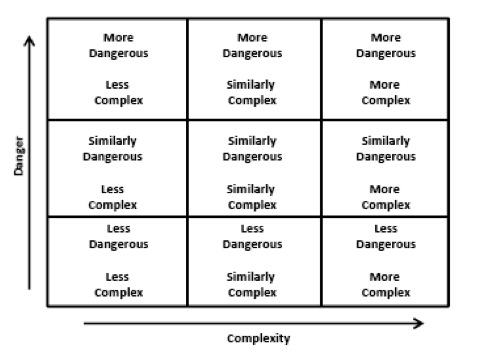
Figure 1.
How a nation-state views itself and its role in the world will assist in determining the extent of environmental complexity and danger. The National Security Strategy (NSS) clearly spells out the U.S.’s role by stating that, “…there should be no doubt: the United States of America will continue to underwrite global security….”[30] It is the belief that underwriting global security enhances U.S. national security through its renewed and respected role as a global leader. Furthermore, the NSS states that America’s “…prosperity is inextricably linked to global prosperity…”[31] and that through collective action with allies and partners, global security and prosperity are enhanced. Ultimately what the U.S. seeks is “A world in which individuals enjoy more freedom and opportunity, and nations have more incentives to act responsibly while facing consequences if they do not.”[32] Underpinning this perspective is the U.S. commitment to international order and global economic growth upon which global stability and prosperity depend.[33] As the US economy is the well-spring of U.S. power, national economic prosperity leads to a more secure nation. A more secure and prosperous nation allows a greater U.S. role in shaping global stability and security. A stable global environment, provides a more secure and prosperous environment, which, in turn, enhances U.S. security and prosperity. The causal proposition is that stability generates prosperity and security.
The outcome of this causal reasoning, stability-security-prosperity, for the Joint Force is that stability becomes the raison d’être for military operations. In fact, the National Military Strategy (NMS) states that, “Our Nation’s security and prosperity are inseparable”[34] and that, “Our vision is a Joint Force that provides military capability to defend our Nation and allies, and to advance broader peace, security, and prosperity.”[35] In this case, peace means order or stability. This causal reasoning, however, is tenuous and perhaps even paradoxical as General Dempsey identifies in the CCJO. Dempsey states that although the world is trending toward greater stability, technologies and adversaries make the world “potentially more dangerous than ever before.”[36] Dempsey’s assessment calls the stability-security proposition into question and demands further analysis of global strategic trends to understand the linkage better.
Understanding one’s mission in the context of the environment is necessary in the development of an organizational design. The JOE: Joint Operating Environment identifies 16 trends within the strategic environment that will affect Joint Force operations.[37] The Sustaining U.S. Global Leadership document identifies 10 primary missions and six core U.S. national interests.[38] The linkage of global trends, missions, and core national interests are listed in Table 1 below.
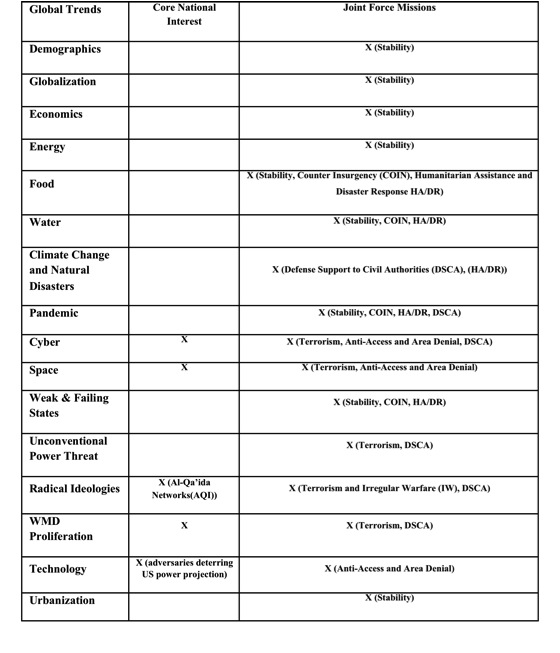
Table 1.[39]
An assessment of the environmental trends highlights the preponderance of Joint Force missions or tasks that involve stability in some manner. As defined in Joint Publication 3-0, Joint Operations,[40] stability operations are those various military missions, tasks, and activities needed to establish, reestablish, or maintain a safe and secure environment. DSCA and HA/DR activities are also stability-related tasks and serve to underscore the security-stability relationship. Equally noteworthy, however, is that these stability-oriented tasks (with the exception of DSCA) do not align with expressed core national interests. As well, the lack of a peer or near-peer conventional competitor is evident in the trends, core interests, and Joint Force missions.
Clearly, the number and type of trends, missions, and interests highlight the complexity of today’s environment. Assessing the three attributes of complexity (component, coordinative, and dynamicity) relative to the strategic environment, one finds that complexity is increasing in large part because of America’s role as the world’s sole superpower, globalization, and the spread of technology. The number of relationships the U.S. has to manage or understand has increased as has the variety of relationships and the change in those relationships over time. As a result of communications technology and social media, local events have a far greater potential than in the past for affecting the strategic environment. Given the current NSS directive that the U.S. will underwrite global security, each event must be assessed for local, regional, and strategic consequences and potentially acted upon whether it serves the Nation’s direct interests or not.
In the context of the Cold War era, the relationship between the U.S. and the U.S.S.R. was interactively simple, and every global problem was assessed in the context of how it would affect the relationship between the two. Although every problem was potentially an issue of national survival, the interaction was part of a well-structured problem. Well-structured, however, does not mean the relationship was not complex or that it was easy (or inexpensive).
The Defense Department’s organizational structure also reflects the increasing environmental complexity over time. For close to 150 years, two military Services (the Army and Navy along with the Marine Corps) were sufficient to handle U.S. national security requirements in the land and maritime domains. As the U.S. became a regional power and global superpower, national security needs led to an expansion into the air domain and the establishment of the Air Force as a separate Service. Over the ensuing decades, the space domain was added and today the cyber domain is in its infancy. This increased specialization is representative of the overall increased complexities within the environment.
The graphic below (Figure 2) provides a picture of the strategic variables, U.S. interests, and missions along with the key foundational facts and assumptions that develops environmental perspective. Although the focus is primarily on the military variable, when integrating the economic, diplomatic, and information instruments of national power, the level of complexity increases substantially. The JOE expands on the Joint Force vision and mission through the identification of five enduring military objectives: the protection of the U.S. and its territories; maintenance of the global commons; deterrence of potential enemies; reassuring partners and allies; and fighting and winning conflicts that may occur around the world.[41] Current and forecasted trends inform and influence these objectives and shape response efforts and organizational design requirements.
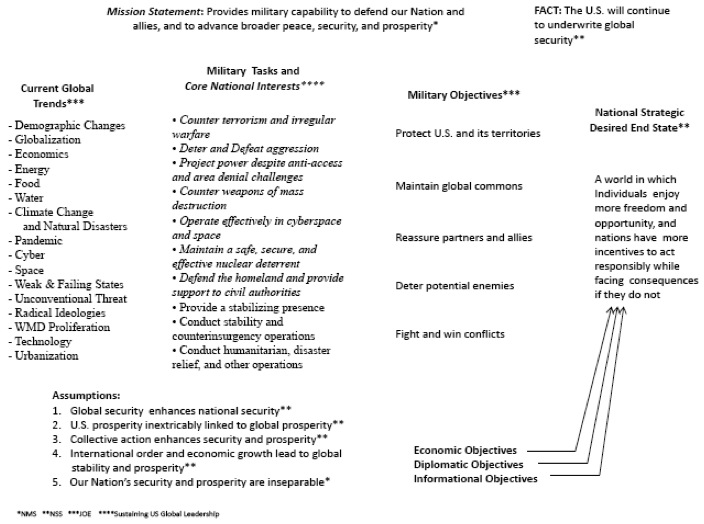
Figure 2.
A cursory analysis of the Cold War time frame would show that the Joint Force mission, global trends, and military tasks would be less extensive and fewer, thus making the world less complex for the U.S. as a nation-state relative to today. The assessment that today’s environment is more complex decreases the range of the two paradigmatic assumptions by two-thirds (see Figure 3) leaving an assessment of the degree of danger to complete the framework.
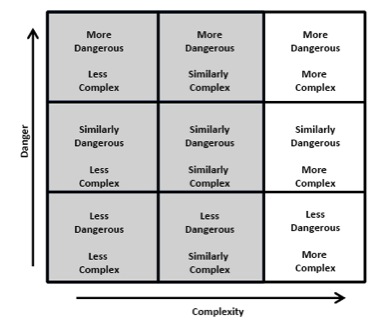
Figure 3.
Globalization and the drive for economic prosperity actually have increased instability as nation states and groups become more competitive for markets, resources, and influence. Unlike the earlier industrialization period for current major and global powers, geographic “white space” has become essentially non-existent bringing competitors into direct contact, and thus conflict with one another. “White space,” or the peripheral areas, served as a geographic relief valve for major powers that reduced the prospects for major conflict or, through the use of proxies, kept conflicts relatively small-scale.[42] Paradoxically, although the world is experiencing far greater conflict and U.S. Joint Forces are involved in multiple operations around the world, when compared to the Cold War period direct physical threats to core U.S. national interests are less.
A world divided by two superpowers is quite different from one divided by many powers. During the Cold War, bipolarity tended to make everything linear—national interest was defined in unlimited terms and the superpowers competed the world over for client states.[43] In fact, as the world was seen in zero-sum terms, the linearity of the Cold War made it far more dangerous than the current non-linear environment. The superpowers refrained from using direct force for fear of escalating the conflict between the two. Today, in an ironic twist, even though the U.S. is the world’s only superpower, the fact there is not a legitimate global antithesis to the U.S. renders the use of its overwhelming military power problematic. Any use of power solely in its self–interest automatically puts the U.S. in a defensive position as it tries to avoid the global “bully” label. Therefore, for all practical purposes, a balance of power marks today’s environment. A balance of power is by nature unstable because every nation seeks to maintain or increase its position in the world, which creates competition. In an effort to compensate for another’s attempted gain, other states must seek their own gains to rebalance the relationship.[44]
Even though a balance of power environment undergoes more frequent conflict than a bipolar environment, the U.S. is in less danger than during the Cold War when there was a threat of large-scale conventional or global nuclear war. The Cold War environment posed a far greater threat to U.S. core values than does the current strategic environment. As a result, our framing assumptions for an organizational design are that the world is “less” dangerous but “more” complex (see Figure 4).
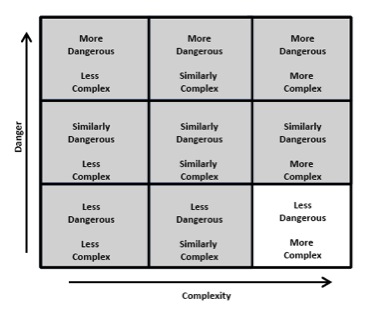
Figure 4.
Table 2 below portrays my assessment of complexity and danger in relationship to the global trends, core national interests, and Joint Force missions as well as the resiliency of the U.S. to respond to and recover from an incident. An intensity of national interest is assigned to each global trend and acts as an indicator of danger to U.S. values. Note that there are no trends assessed as “survival,” and there are three trends assessed as “vital”: economics (the health of the U.S. economy), cyber, and space. The Cold War era would have identified conventional war and nuclear war as “survival” interests

Intensity of Interest: S – survival, V – vital, M – major, and P – peripheral.
Table 2.
Joint Force 2020 and a Suggested Organizational Design
Given national interests, trends, and tasks as well as the levels of complexity and danger associated with the current and future environment, developing a Joint Force capable of providing security for the U.S. begins to emerge. The diagram below (Figure 5) identifies the broad capabilities needed to address the global trends that affect U.S. national security. Although the threat of conventional warfare has decreased, and will continue to decrease according to General Dempsey, [45] retaining critical skills and competencies is necessary as a hedge against potential future adversary developments.
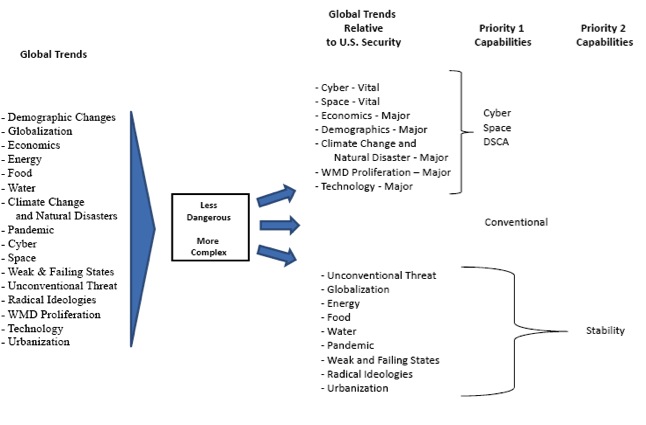
Figure 5.
Linking capabilities to military objectives reconfirms the priority order of capabilities. Examining these capabilities provides further insight into the broad organizational design attributes that must compose Joint Force 2020 (see Figure 6). Cyber, space, and DSCA form the primary capability areas. Centrally organized and postured within the U.S., these functional organizations smooth the transfer of information, analysis, intelligence, and contacts facilitating greater levels of specialization. Organizing by function allows the Joint Force to present a consistent point of contact to other interagency members, allies, partners, and other actors, and allows the sharing of resources and expertise across geographic lines as needed. Organizing along functional lines also promotes standardization while reducing duplication of resources and personnel.[46] The organizations are “inside-out” meaning that their focus is on the protection and resiliency of the U.S. and defending forward as required. These organizations have task-tailored teams on-call that are globally deployable as circumstances demand.
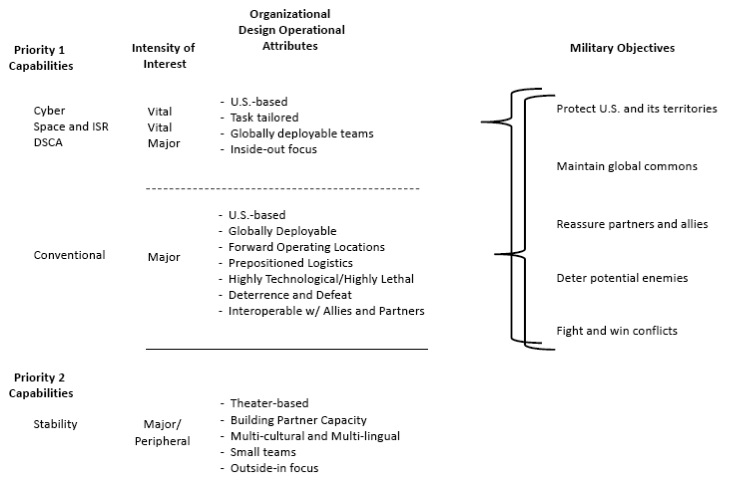
Figure 6.
The Joint Force requires a conventional capability that is primarily U.S. based but capable of short-notice global deployment and execution. This traditional warfighting organization is highly technical and highly lethal, capable of inflicting severe damage on any potential foe, thus providing a highly effective deterrence force. In the event that a potential adversary did act aggressively, it is capable of defeating any fielded force. This warfighting capability is interoperable with regional partners and allies, but does not have the capacity for sustained or extensive occupation. This capability provides the force that underwrites the majority of global security needs. Composed primarily of full-spectrum air and maritime (to include Marines) capabilities, this organization addresses crisis action and contingency planning and execution requirements. Using primarily a product or plan process, which gives the organization plan development and execution responsibilities and authorities, allows the organization to develop diverse plans and facilitates rapid plan development.[47] This warfighting mission, to include the maintenance of the Nation’s nuclear capabilities, requires coordination with cyber and space functional organizations and stability organizations.
Geographically based, the required stability capability focuses on building partnership capacity using the Special Forces model of small training and assistance teams that possess multicultural and multi-lingual skills. These organizations are “outside-in” focused meaning that through their extensive understanding of the local and regional environment they are sensitive to threats undermining U.S. security interests. Regional or sub-regional organizations based upon the current combatant command model are needed as operations require a close relationship with allies and partners. A geographic focus conserves scarce regional expertise and allows the management of activities by a relatively few experienced personnel.[48] These organizations are also the focal point of efforts for any humanitarian assistance or disaster response missions.
Each of these organizations require support by processes that cross-cut boundaries, such as planning, programming, and budgeting. These organizations manage a process’ complete work flow from initiation to implementation, facilitating functional or geographic stakeholder participation throughout. Individuals from stakeholder organizations work together as a process team breaking down vertical organizational “stovepipes,” reducing friction across organizational boundaries, reducing development times, and eliminating duplication of effort.[49] Traditional Joint Staff and Service organizations would form the preponderance of process-oriented requirements.
Conclusion
General James Mattis stated that, “Every military force in history that has successfully adapted to the changing character of war and the evolving threats it faced did so by sharply defining the operational problems it has to solve.”[50] Current strategic guidance documents, however, lack much-needed specificity and rely upon catchphrases and hyperbole to defer the tough decision-making necessary for addressing the national security challenges that face this Nation. The CCJO provides the necessary vision for a more detailed approach. Any approach, however, must begin with a discourse regarding the validity of the paradigmatic assumptions driving force development. Is the world more complex? Is it more dangerous? Are security, prosperity, and stability linked and does the underwriting of global security serve the best interests of the United States? Can the U.S. afford to provide security for the world? Can it afford not to? Keeping in mind that every increment of security must be paid by additional sacrifices of other values, the law of diminishing returns suggests that at some point gains in global security no longer compensate for the added costs of attaining it.[51]
To go forward, senior leaders must make conscious, reasoned choices that address strategy and environmental mismatches. They must reorganize the DoD and Joint Force to give it the ability to adapt over time as the environment changes, the agility to react to dynamic conditions, and the resiliency to respond to disruptions or shocks. Senior leaders must develop a force that is “upside down” when compared to today’s force structure. It must consist primarily of robust cyber and space forces and be augmented with small but lethal global, high-tech, conventional forces. A secondary effort must facilitate building partner capacity through the use of special operations and other similarly oriented forces.
Assumptions about the environment drive future force organizational design. Given that the environment is more complex, but less dangerous than in the Cold War era, the way ahead appears clear. Fiscal realities demand difficult and uncomfortable decisions, and we may not end up with the military we want or envision; it will, however, be the military we need.
[1]Daniel H. McCauley, Goldwater-Nichols II: It’s Not What You Think. Small Wars Journal (October 2012).
[2] Nora Bensahel, Olga Oliker, Keith Crane, Richard R. Brennan, Jr., R., Heather Gregg, Thomas Sullivan, and Andrew Rathmell, A. After Saddam: Prewar planning and the occupation of Iraq (Arlington, VA: RAND Corporation, 2008).
[3] Martin E. Dempsey, Capstone Concept for Joint Operations: Joint Force 2020 (Washington, DC: U.S. Government Printing Office, 2012).
[4] Martin E. Dempsey, Mission Command White Paper (Washington, DC: US Government Printing Office, 2012).
[5]Toby Hatch, and Nigel Youell, The Challenge of Strategic Alignment (A FSN and Oracle White Paper, 2008). Retrieved from: : http://www.oracle.com/us/solutions/business-intelligence/064027.pdf
[6] Harry R. Yarger, Strategic Theory for the 21st Century: The little book on big strategy. The Letort Papers (US Army War College, Carlisle, PA, 2006).
[7] Richard Daft, Theory and Design of Organizations (Singapore: Cengage Learning, 2010).
[8] Harry R. Yarger, Strategic Theory.
[9] Daniel H. McCauley, The Facets of Mission Command. Small Wars Journal (June, 2012).
[10] David Bohm, The Special Theory of Relativity (New York: Routledge, 1965).
[11] Martin E. Dempsey, Capstone Concept for Joint Operations.
[12] Martin E. Dempsey, White Paper on Joint Education (Washington, DC: US Government Printing Office, 2012).
[13] Martin E. Dempsey, Mission Command.
[14] Leon Panetta, Sustaining U. S. Global Leadership: Priorities for 21st Century Defense (Washington, DC: U.S. Government Printing Office, 2012).
[15] David Jonassen, Learning to Solve Problems (New York: Routledge, 2011).
[16] Martin E. Dempsey, Capstone Concept for Joint Operations.
[17] Martin E. Dempsey, Chairman’s Strategic Direction to the Joint Force (Washington, DC: U.S. Government Printing Office, 2012).
[18] Martin E. Dempsey, White Paper on Joint Education.
[19] Arnold Wolfers, ‘National Security,’ as an Ambiguous Symbol, Political Science Quarterly (Vol. 67. No. 2, 1952).
[20] Arnold Wolfers, ‘National Security,’ 481.
[21] Merriam-Webster’s Collegiate Dictionary (Springfield, MA: Merriam-Webster, Inc., 2001).
[22] Ibid., 292.
[23] Harry R. Yarger, The strategic appraisal: The key to effective strategy. Chapter 4, USAWC Guide to National Security Issues, Vol. 1: Theory of War and Strategy (Strategic Studies Institute, US Army War College, June, 2008), 53.
[24] Harry R. Yarger, The Strategic Appraisal.
[25] Arnold Wolfers, ‘National Security.’
[26] Gary Yukl. Leadership in organizations (Englewood Cliffs, NJ: Prentice Hall, 1989), 188.
[27] Micheal G. Roskin, National Interest: From Abstraction to Strategy. (Strategic Studies Institute, Carlisle Barracks, PA, 1994).
[28] Harry R. Yarger, The Strategic Appraisal.
[29] A wholly different discussion would ensue if complexity and danger for individuals was in question.
[30] Barak H. Obama, National Security Strategy, The White House (Washington, DC: U.S. Government Printing Office, 2010), 1.
[31] Barak H. Obama, National Security Strategy, 2.
[32] Ibid., 2.
[33] Ibid.
[34] Michael G. Mullen, The National Military Strategy of the United States of America. Department of Defense, The Joint Chiefs of Staff (Washington, DC: U.S. Government Printing Office, 2011), 1.
[35] Ibid., Preface.
[36] Martin E. Dempsey, Capstone Concept for Joint Operations, iii.
[37] The JOE was one of the primary documents used in developing the CCJO. Mr John DeFoor, Joint Concepts Division, Joint Staff J-7, “Capstone Concept for Joint Operations: Joint Force 2020,” briefing to the Joint Forces Staff College, on 26 Sept 2012.
[38] Leon Panetta, Sustaining U. S. Global Leadership.
[39] The 10 missions listed in Sustaining U.S. Global Leadership (counter terrorism and irregular warfare (IW); deter and defeat aggression; project power despite anti-access/area denial challenges; counter weapons of mass destruction (WMD); operate effectively in cyberspace and space; maintain a safe, secure, and effective nuclear deterrent; defend the homeland and provide support to civil authorities (DSCA); provide a stabilizing presence; conduct stability and counterinsurgency operations (COIN); and conduct humanitarian (HA), disaster relief (DR), and other operations), may be better understood as tasks needed to be accomplished to fulfill the Joint Force mission. As previously stated, the Joint Force mission is to provide “the military capability needed to defend our Nation and allies, and to advance a broader peace, security, and prosperity” (NMS, 2011).
There is also significant overlap between the ten missions and the six core national interests (defeating al-Qa’ida and its affiliates and succeeding in current conflicts; deterring and defeating aggression by adversaries, including those seeking to deny our power projection; countering weapons of mass destruction; effectively operating in cyberspace, space, and across all domains; maintaining a safe and effective nuclear deterrent; and protecting the homeland).
[40] Joint Publication 3-0, Joint Operations, (2011).
[41] United States Joint Forces Command, The JOE 2010: Joint Operating Environment, Joint Futures Group (J59), 112 Lake View Parkway, Suffolk, VA 23435, (2010), 60.
[42] Robert D. Kaplan, The Revenge of Geography (New York, NY: Random House, 2012).
[43] Micheal G. Roskin, National Interest.
[44] Robert D. Kaplan, The Revenge of Geography.
[45] Martin E. Dempsey, Capstone Concept for Joint Operations.
[46] Jay R. Galbraith, Designing Organizations (San Francisco, CA: Jossey-Bass, 2002).
[47] Jay R. Galbraith, Designing Organizations.
[48] Jay R. Galbraith, Designing the Global Organization (San Francisco, CA: Jossey-Bass, 2000).
[49] Jay R. Galbraith, Designing Organizations.
[50] United States Joint Forces Command, The JOE 2010, Forward.
[51] Arnold Wolfers, ‘National Security.’
About the Author(s)
Comments
Hubba Bubba---interesting note---orginally the AF started the EBO thing---then the Army kind of signed on to it after the AF dropped it, and then the Army kind of let it die a quiet death---interesting fact is that the CTCs (NTC/JRTC) have been driving their CTC scenarios and now DATE scenarios all on EBO.
In 2006, the NTC COG then COL Salazar now retired BG Salazar had the NTC create scenarios using EBO---not sure that the BCTs that went through the NTC starting in 2006 realized they were in fact exercising EBO. The software program that was being used to generate the scenarios was designed with EBO in mind, and it is still in use at the NTC. Initially the JRTC resisted it's use, but by late 2006 early 2007 they were using it as well--both are still are using it for now the DATE scenarios.
Did a General kill EBO, or did EBO fail on it's own? It is, by design, a uni-minded system...thus it falsely reduces complexity- or skews it for an organization's perspective during sense-making.
I agree that quoting any leader lends little to an argument when we attempt to swap facts with opinions...but as for EBO, and currently MDMP- I think that the proof is in the pudding; and there is not much edible pudding in OEF or OIF based on the past 11 years.
Will design theory disrupt and create a paradigm shift? Perhaps- or if it is, like EBO, flawed- then it will be a flash in the pan and gone. If it is remarkably better, then our organization will either lead the way and transform with it, or we will eventually do this after our enemies and rivals demonstrate that it works by defeating us. Over, and over, and over...
Hubba
GEN Mattis: "Every military force in history that has successfully adapted to the changing character of war -- and the evolving threats that it faced -- did so by sharply defining the operational problems it has to solve."
Guys-this is the same professional who killed EBO by citing one (1) negative study.........read the JFCOM memo he wrote. Not saying he's entirely wrong, but when anyone tells me 'every blah blah in history blah blah blah' my eyes glaze over and I have to ask them ok, show me which books you are reading..........
Generalizations such as this really bother me. Your other observations I can agree with but I'm not convinced that 'sharply defining the operational problemss...' works when faced with a rag-tag set of opposing individuals linked together with cell phones and non-hierarchical (sp?) organization.
tom
GEN Mattis: "Every military force in history that has successfully adapted to the changing character of war -- and the evolving threats that it faced -- did so by sharply defining the operational problems it has to solve."
Let me suggest that the operational problem that has to be solved in the 21st Century is, in some respects, the same operational problem that had to be solved in the 20th Century, to wit:
How to convince -- and/or compel -- outlier states and societies to:
a. Abandon their less-market-oriented/less-market-friendly values, attitudes, beliefs, practices and institutions and
b. Adopt our more-market-oriented/more-market-friendly values, attitudes, beliefs, practices and institutions in their place.
In the 20th Century, we had some degree of success in this mission causing, via "containment" etc., pro-market changes in such important countries as, for example, China, India, Russia and Brazil.
In the 21st Century, the problem becomes:
How to cause/produce pro-market changes in those remaining states and societies whose less-market-oriented/less-market-friendly values, attitudes, beliefs, practices and institutions still stand in the global economy's way? This, so that we might be able to adequately provide for, keep peaceful and, thus, sustain, our hard-won 20th Century gains.
Herein, let us ask ourselves whether an "upside down" force structure (when compared to today) -- "consisting primarily of robust cyber and space forces, etc., etc., etc.," (see the 2nd paragraph of the author's "Conclusion") -- will such a force structure have any real utility as to the core 21st Century operational problem noted in my paragraph immediately above?
"Design" remains for many to be the 800lb gorilla in the room, and this may be rightfully so. Perhaps my usage of "design" is limited or altered, but it works for me. That said, here's my take on it and complexity:
The way to mitigate complexity is by understanding it the best that you can. A deep understanding of the environment as it exists - including the nature of the relationships within it and how they effect one another - is critical. Granted, this understanding may never be as deep as we want or need it, but this does not preclude us from making every effort necessary to attain it. This includes understanding the motivations of the players and knowing their causal and dependent relationships.
We must understand what the problem is that we are trying to solve. This allows us to define the mission and format a strategic map describing how we will accomplish it.
Operations are tempered against our understanding of the environment as it exist in real time (or as best we can ge to "real time") and our expectations of how these operations will affect the environment - particularly in regard to those causal and dependent relationships. Yes, this is an assumption, but our understanding of the environemnt and the relationships within should mitigate much of the uncertainty in environmental response.
The complex environment is dynamic, evolving both on it's own (emergence) and in response to our actions. The understanding and evaluation of the environment is therefore ongoing. As we conduct our operations the environment necessarily changes. We must be ongoing and honest in our evaluations of the environment. Did our actions cause the changes we expected? If so, was this only becasue of our actions or did other factors assist? If not, how did it change and why? Based on this new understanding and shape of the environment, what do we do now?
What is the value of lessons learned? As I've said in previous comments, lessons learned are most applicable immediately after they are learned and likely decrease over time. They decrease because the environment to which they applied has likely changed owing to the actions that casued the lesson learned. As such, they can inform our decision making but must be understood in context: What is the environment now and what was the environment then?
"It must consist primarily of robust cyber and space forces and be augmented with small but lethal global, high-tech, conventional forces."
1. No surprise here that a career USAF officer wants cyber and space in the forefront, with conventional forces taking a back-seat. This reminds me of Builder's thesis on how each military institution absolutely racks their service above others, even at the expense of the nation (see Masks of War for more).
2. Lots of "operational design" in the logic here, as well as hints of some Effects Based Operation logic in many of the linear, over-simplified charts that create the illusion of 'control' of the future neatly fitting into any of the prescriptive, categorical boxes in any of the said charts.
3. Rarely do I find any doctrine, including the current CCJO, as particularly more useful than other policy or doctrine...because where you stand depends on where you sit (also a great article on considerations of institutional bias). I worry that the author is so insulated from thinking outside the Joint, Air Force and inner-joint bureaucracy that he cannot avoid becoming an echo chamber for Air Power (or in this case, Space and Cyber) triumphing over all...despite the argument falling in upon itself with any critical reflection.
4. Differentiating between complexity and danger is illogical...and one-dimensional. This is purely linear, reductionist thinking- risk and danger do not necessarily increase with complexity. Complex systems are not "scary" due to what they are; they are scary for how we as institutions perceive them. We crave certainty- to the point that our professors in PME write articles like this...because the illusion of reducing uncertainty appears to reduce danger. Making things less complex by reducing, categorizing, or using pseudo-scientific methodologies to "show us" how to reduce complexity promises to tame the beast...
5. Strange that SWJ meta-tagged this with "design." No design in this one...perhaps 'operational design' mixed with MDMP and some EBO...
Would like to see what the design gang at SWJ thinks of this?
Hubba
